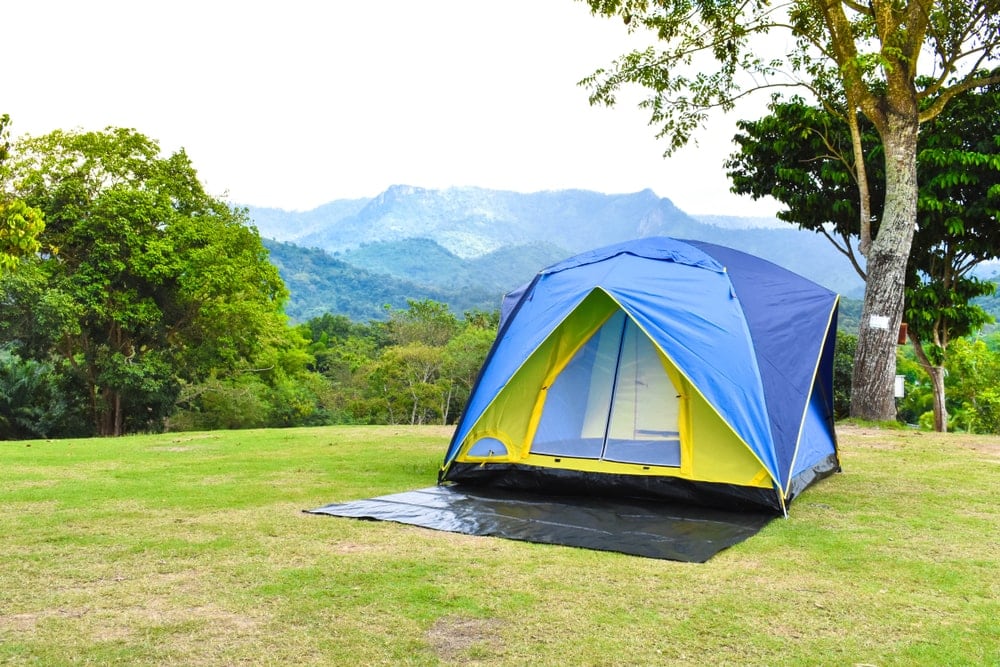In hostile conditions, putting a camouflage tarp underneath your tent might offer defense and additional waterproofing for your shelter. There isn’t a necessity for you too, especially in pleasant weather. However, if you decide to use a tarp, purchase one that is sufficiently portable for your activities.
At some point, if you spend enough time outside, you’ll probably notice someone throwing a camo tarp down beneath their tent. But is this actually necessary? Is a tarp really necessary to place beneath your tent?
Although it is unnecessary, putting the tarpaulin under the tent system is a well-liked method of shielding your shelter from harm at night. Additional weatherproofing, such as tarps can shield you and your belongings from the drenched ground beneath your tent.
Having said that, you undoubtedly have a lot of questions about how everything works if you’ve never used a tarp for tent. We’ve put up this overview of tent footprints to get you started.
In this article, we’ll go over the most important things you need to know about utilizing a ground tarp for tent when camping. In this manner, regardless of the weather, you can have an incredible time in the mountains.
Click here – What Is Interprocess Communication MCQ?
The debate of whether it is necessary to have a tarp under the tent
The argument about using tarps under tents is almost as old as camping itself. Some campers use ground cloths religiously, while others wouldn’t risk being discovered in the mountains with them. So, Is a tarp really necessary to place beneath your tent?
Although a tent footprint isn’t strictly necessary, using one throughout your adventures has a lot of benefits. But hauling a ground tarp while camping has its disadvantages.
Let’s examine some pros and cons of employing tent ground covers to end this argument once and for all.
Advantages of using tarps under tents
A tarp can be a great addition to most camping kit lists if you’re worried about remaining dry during a storm. The following are some benefits of placing a tarp underneath your tent:
1.It helps protect your tent
The fact that a tarp offers a lot of protection for your tent may be the largest advantage of employing a ground cloth. Consider this: Your tent floor experiences significant wear and tear while you are outside, particularly if you are camping in rocky or uneven terrain. Therefore, a ground cover might prevent damage and abrasions to your tent. As a result, a tent footprint can extend the life of your tent and help you save money.
2.Improved waterproofing
The ground around you will eventually get sodden if you are camping during a downpour. The likelihood that water will be able to leak through the floor of your tent increases when this occurs. In order to avoid water seeping into your sleeping space, use a ground cloth underneath your tent. Additionally, it keeps your tent from being overly moist.
3.Additional Insulation
Using a tarp under your tent adds a little bit of extra insulation between you and the ground, even if tarps aren’t the best insulators. This may result in a better night’s sleep and greater energy for hiking the following day on a cool evening.
4.Post-Trip Cleaning is made simple.
A tent footprint keeps your gear clean while you’re outside by acting as a barrier between your tent and the ground. Even though your ground fabric will probably become very muddy and filthy, a tarp is considerably simpler to wash than a tent. Consequently, employing a tarp can speed up and improve the effectiveness of your post-trip cleanup.
5.It makes it easy to pitch the tent.
Last but not least, carrying a tent footprint might make setting up your tent much simpler. You may easily spread out your ground cloth to gauge the area if you’re unsure whether your shelter will truly fit in a potential tent site. It’s much simpler to do this than to pitch your complete tent just to discover that it won’t fit in the desired place.
Disadvantages
1.Additional weight and bulk
Adding a tarp to your camping checklist will make your load heavier. Tarps can also be rather heavy, making loading your equipment difficult. Of course, this might not be a big deal if you’re car camping. But for extremely light backpacking journeys, it’s a disadvantage that’s important to take into account.
2.Additional cost
Tarps are an additional investment, even though they aren’t the most expensive piece of equipment you’ll need to purchase. This is especially true if you want to spend a significant amount of money on a manufacturer-built ground cloth. But you can frequently save cash by creating your tent footprint from a painter’s tarp.
What is the appropriate size tarp for tent protection?
A tarp is only beneficial if it fits your tent properly in terms of size. A model that is too small won’t give you the trail protection you require. On the other hand, a model that is overly large will result in you carrying more weight and mass than is necessary.
Unfortunately, there is some disagreement on the tarp size necessary for tent protection. While some people contend that your ground cloth should be a bit larger than the size of your tent, others disagree.
The size of the tent itself, however, ultimately determines the best tarp size for your tent. Finding a tarp that is roughly the same size as your shelter is excellent, though a few inches here and there won’t make much of a difference.
The important thing to remember is that your tarp shouldn’t be noticeably bigger or smaller than your tent. A pool of water could grow under your cover if your tarp is too big and begins to gather water. Alternatively, if your tarp is too tiny, it won’t provide your equipment with enough protection.

